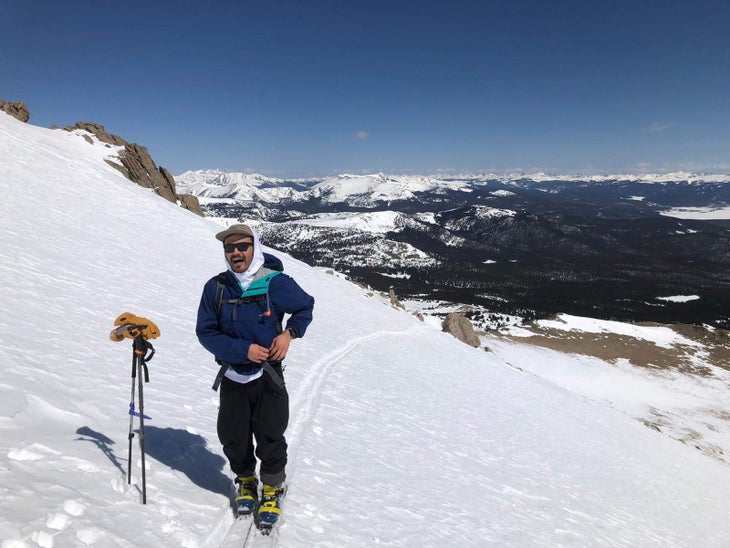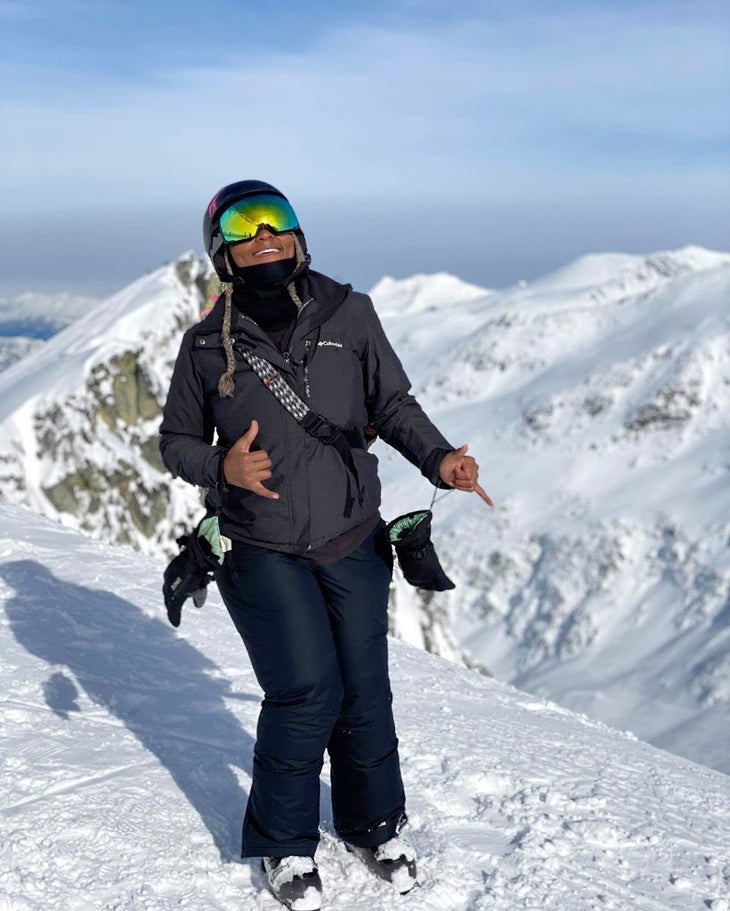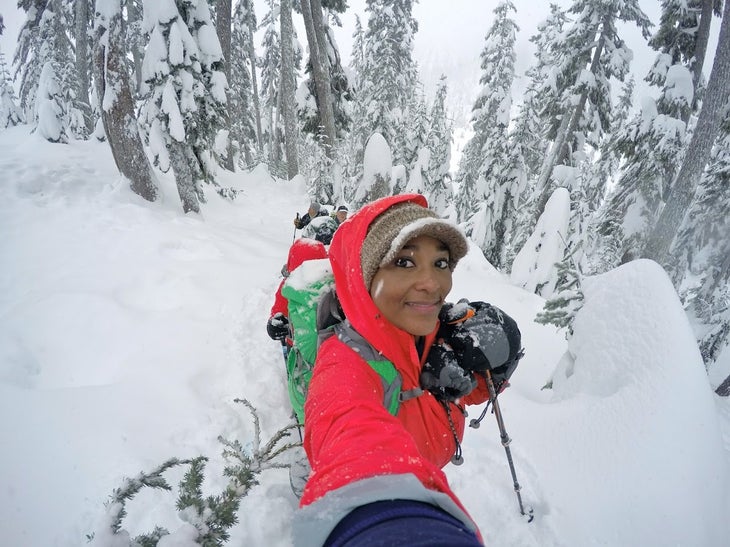Heading out the door? Read this article on the new Outside+ app available now on iOS devices for members! Download the app.
It was when I saw a zippy Audi A4 zoom pass me in Boulder, Colo. Complete with its fancy rooftop gearbox, studded snow tires, and a “Trump Skis in Jeans” sticker plastered to its shiny new bumper, I found myself wondering:
I wondered about a Pennsylvania farming family making a pilgrimage to Killington Ski Resort to spend its hard-earned money on Vermont’s tourism. And about inner-city kids borrowing hand-me-down gear to make their first turns with SOS Outreach, a program designed to introduce disinvested communities to adventure sports.
I thought about the ranch kids I went to elementary school with on Colorado’s Western Slope, who knew how to brand a calf and bale hay before they could spell and made the 50-minute drive to Telluride Ski Resort to ski once or twice a year. And I thought about the Amish men and boys who frequent Wolf Creek Ski Area located in Southern Colorado. A lot of these skiers can quite literally be seen skiing in jeans, and, depending on who someone is, skiing in jeans may be a source of pride.
Related: Independents Day – Wolf Creek
I wrote those thoughts down in March 2019, left them alone, and went on living my privileged existence as a white woman.
Skiing’s inherent nature attracts the kind of people who are willing to sacrifice comforts as small as having cold hands all day and as big as forgoing salaried careers, homeownership, or other traditional life paths all for the quest of feeling the freedom that sliding on snow provides. It often attracts fun-loving, funny people who love challenging the status quo.
When the phrase “Trump Skis in Jeans” (which borrowed heavily from the early 2000’s sticker referring to the former Vice President, “Cheney Skis in Jeans”) first made its rounds in 2016 across the younger, progressive ski scene, it was meant to be funny. It could be seen on stickers, heard chanted in lift lines, and shared around social media. Many chalked it up as a cheeky sentiment saying, “this guy doesn’t know what he’s doing.”
Fast forward to June 2020, when the Instagram posts from a skier named Garry Schlag caught the outdoor community’s attention. Schlag is multiracial with Japanese and Irish heritage and was questioning the language skiers use at the expense of others, like “Trump Skis in Jeans” and “Gapers” and was calling into attention overtly racist phrases like “Chinese Downhill” and “twinkies”.

Schlag said he was called a “twinkie” by adult coaches and teammates as early as the age of 11 while growing up and competing in mogul skiing in Park City, Utah. He defines the term as “a slur so chosen to communicate to me the racist idea that I am yellow on the outside and white on the inside.” Simply because he was skiing, he was inferred as “white on the inside”, which Schlag says highlights the “internalized the idea that skiing is a white space.”
He pointed out that the racist term “Chinese Downhill” has origins traced back to the 1984 film, “Hot Dog,” and highlighted how terms like “gapers” and “jerries”, which are often used to refer to newbies to the sport, act as disparaging tools for elitism, embarrassing beginners in the sport and thereby fueling a culture of exclusion.
“Class and race are inextricably linked,” he said when addressing the idea that skiing’s barriers are more class-related than race-related. “I believe there are far more poor white people skiing in the USA than there are people of color from any class.” But, he said, the “barriers to entry in skiing keep BIPOC folks from participating in large part due to centuries of systemic racist policies, policing, segregation, and a plethora of other factors including workplace discrimination that keep BIPOC from enjoying the same economic freedom as white people.”
His post also questioned issues outside of language, like the appropriation of urban-inspired attire and hip-hop music used in ski edits, and the use of marijuana by white teenage skiers that would simultaneously put young BIPOC in prison in other regions of our country.
“I wanted to start a conversation,” says Schlag. “It does make me feel nervous to talk about it. That discomfort is necessary, and that nervousness comes from internalized feelings of privileging white comfortability over speaking my own truth.”
With civil unrest widespread and the call to address and end systemic racism reading loud and clear across the country, the ski community has come face to face with its lack of diversity and white-centric existence. Questions around representation, access, as well as the intersectionality of race and class dynamics are being highlighted. At the core of these conversations, how people talk has been centralized.
“Language matters,” says Danielle Williams, the Senior Editor of the blogging platform Melanin Base Camp (MBC), focused on increasing the visibility of BIPOC in outdoor spaces and outdoor media. She says MBC has moved away from specific outdoor language “steeped in white supremacy and ableism.”
“Over time, we’ve changed our language to reflect goals of racial equity, inclusivity, and a respect for the land and Indigenous people,” Williams says. “We are guests on Native land and using language that reflects humility and respect (as well as Native land acknowledgments) is something we value.”
Williams said they have removed words like ‘shred,’ ‘explore,’ or ‘conquer’ in MBC articles because “there’s nothing to conquer” in the context of “adults engaging in outdoor recreation.”
“We no longer call our bloggers ‘adventure athletes,’,” she says. “Not because the term is inherently bad, it just comes across as elitist, inaccessible and very white, when the majority of our audience identifies as Black, Indigenous and People of Color,” she explains.
Exclusivity in the sport of skiing can act as a self-perpetuating cycle, where skiers, whether they know it or not, are actively excluding and harming BIPOC through language and therefore having a real-time impact on people who are out on the slopes, engaging with the sport.
Annette Diggs, a Black female Ski Instructor at Steven’s Pass says she fell in love with skiing three years ago and decided to start teaching to provide BIPOC representation while she’s instructing.
“I freakin’ love teaching,” she says. “Helping others become better skiers and overcome emotional barriers on the hill makes me incredibly happy. It’s so rewarding.”

“It’s a total culture shock for some students when they see they have a black ski instructor. I had one kid that kept on saying, ‘you’re Black, you’re Black’ and all I can do is laugh and say ‘yes.’ I know this kid was mentally registering something that he didn’t think was possible.”
She’s also encountered microaggressions and has been told she’s “out of her element” for simply being on a chairlift, which is seen as a predominantly white space. But she says this is one of the reasons why she has opted to become a ski instructor, so she can work to change the narrative in skiing. That, and because she loves to ski.

Williams says Melanin Base Camp’s goal isn’t just to simply “cut and paste Black and Brown people into predominantly white sports, but to create new models that resonate with our communities, for interacting with the land and for engaging in conservation and outdoor recreation.”
What if skiing took this same route? Aside from addressing the plethora of barriers facing BIPOC folks in the world of winter sports, from problems in access to representation and leadership, simply reexamining how we talk could do wonders.
At the heart of it all, the sport is reckoning with how much of its existence is rooted in privilege.
What if we dropped the “I’ve skied all my life” attitude of implied privilege and chatted with those folks non-ironically wearing hand-me-down windbreakers and jeans sitting across from us at the bar? Or the fully capable Black Ski Instructor or crew of Black skiers on the chair lift? What if we recognized how people from different backgrounds and BIPOC are trying to navigate this extremely white, privileged outdoor space and made them feel welcome and not the butt of a joke?
If skiing really is freedom, and skiers still love to challenge the status quo, the time has never been better to change the language we use to make everyone feel welcome to our sport.
Keep Going: The Color of Skiing
The US Ski Team Can Do Better: A Letter from Team President Tiger Shaw
Lost in Translation: The Language of Skiing
